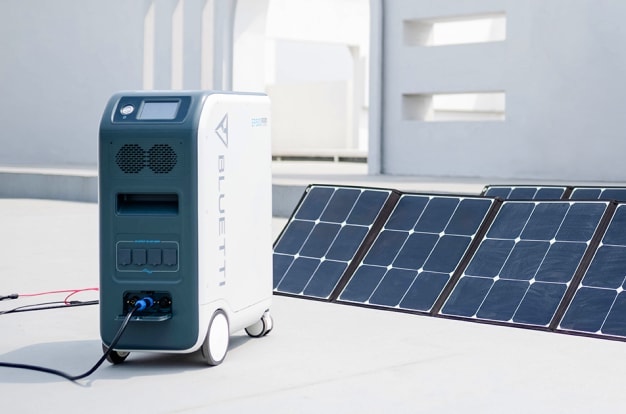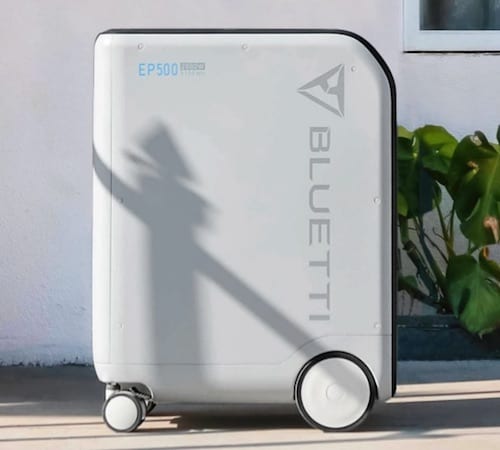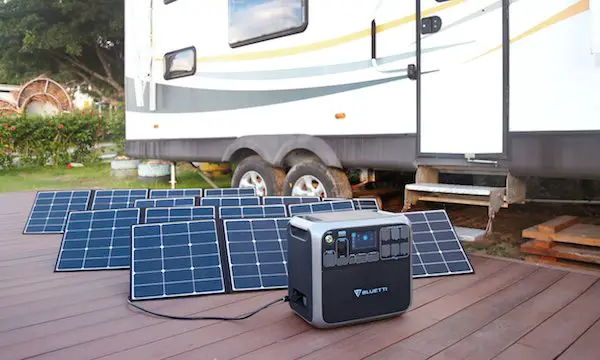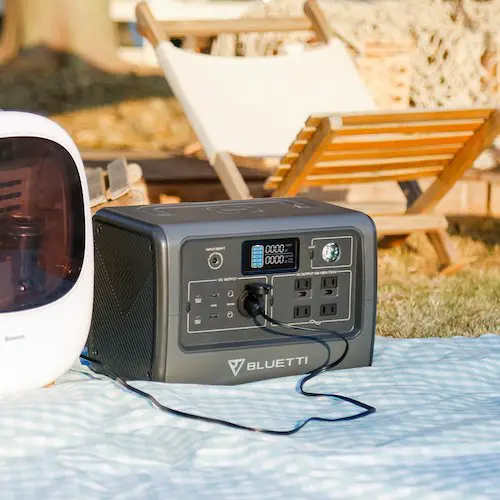In this article, I’ll be sharing my top five solar generators that use LiFePO4 batteries of various sizes. I’ll discuss their features, specifications, benefits, and downsides to give you a well-rounded understanding of each model.
Here’s a brief overview of what you’ll discover in this post:
- What is a LiFePO4 solar generator and what makes it unique?
- Here I reveal my rankings of the top five LiFePO4 solar generators.
- Up next I compare the general specs side-by-side for each model.
- My #1 LiFePO4 solar generator pick has a powerful setup as well as several advanced tech.
- The #2 selection has multiple variations to customize your system.
- Number three on the list is powerful, compact for its capabilities, and 17 output ports.
- The 4th solar generator is for serious off-grid power needs. It’s large and has impeccable performance.
- Last on the list is nearly the opposite of the prior model. It is by far the lightest of the five models and is ideal for mobile use.
What Is a LiFePO4 Solar Generator?
A LiFePO4 solar generator is an off-grid energy storage system that harnesses solar energy to provide electricity for various applications. It mainly consists of solar panels, a charge controller, an inverter, and a LiFePO4 (lithium iron phosphate) rechargeable battery.
When compared with lithium-ion batteries, LiFePO4 batteries have two performance features that make them ideal for use in solar generators- a longer lifespan (battery cycle life) and enhanced safety that reduces the risk of thermal runaway.
Best LiFePO4 Solar Generators – Quick View
Here is an overview of my selections as well as a little information regarding their key qualities:
| Model Ranking | Highlights |
|---|---|
| 1. Best Overall – Bluetti EP500Pro | Supports UPS, Long cycle life, High input & output |
| 2. Best AC Output – EcoFlow Delta Pro | Up to 4,500W AC output, Expandable batteries, Multiple configurations |
| 3. Best Multipurpose – Bluetti AC200P | Several output port options, Inexpensive for its size & capabilities |
| 4. Best Solar Input – Renogy Lycan 5000 Power Box | 4,400W max solar input, Expandable batteries, IP55 rating |
| 5. Best Portability – Bluetti EB70S | Lightweight, Inexpensive, Long cycle life |
The Bluetti EP500Pro is the best LiFePO4 solar generator because it leads the industry with a battery cycle life of 6,000+ cycles. Its 5,100Wh battery provides its AC ports with a maximum of 3,000W continuously. It can also recharge in as little as 2.6 hours from solar panels (2,400W max).
You can read my in-depth review and analysis of the Bluetti EP500 and EP500Pro here: Bluetti EP500 & EP500Pro Review – Longest-Lasting Solar Generators.
However, the EP500Pro may be too expensive or too large for your needs, so I have included four other LiFePO4 solar generators of various prices and sizes that may be a better value to you.
Check out their specifications in the table below.
5 Best LiFePO4 Solar Generators – Key Specifications
| Model | 1. EP500Pro | 2. Delta Pro | 3. AC200P | 4. Lycan 5000 | 5. EB70S |
|---|---|---|---|---|---|
| Made By | Bluetti | EcoFlow | Bluetti | Renogy | Bluetti |
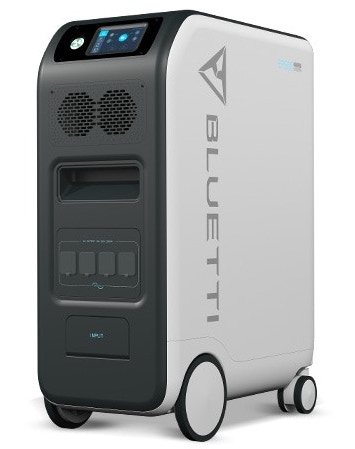 | 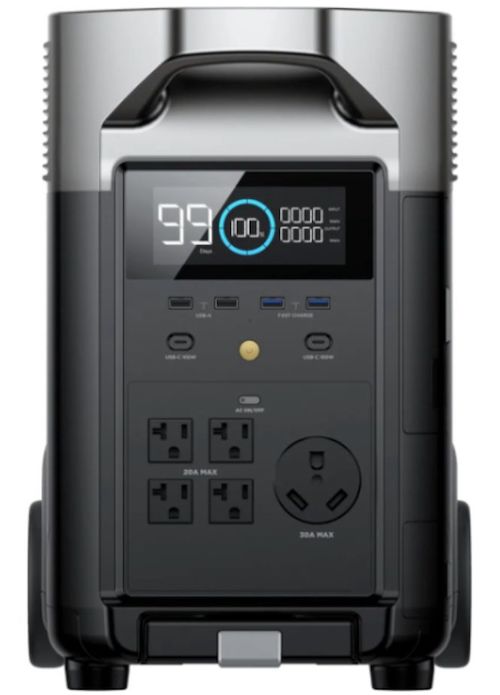 | 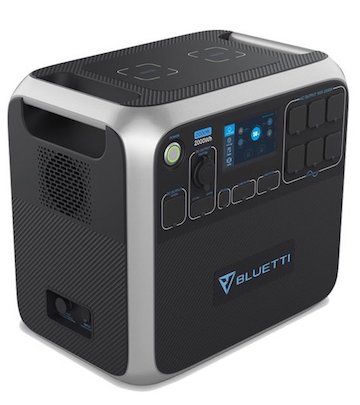 | 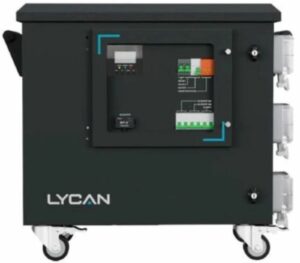 | 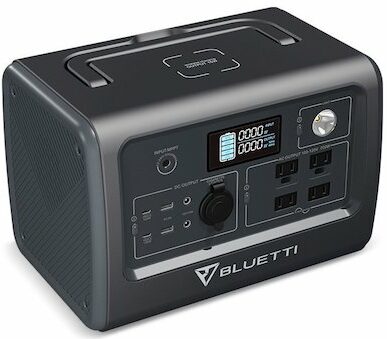 | |
| Battery Capacity | 5,100Wh | 3,600Wh | 2,000Wh | 4,800Wh | 716Wh |
| Cycle Life* | 6,000+ cycles | 3,500 cycles | 3,500+ cycles | 4,500 cycles | 2,500+ cycles |
| Battery Expansion? | Yes | Yes | No | Yes | No |
| AC Output | 3,000W (6,000W surge) | 3,600W (7,200W surge) | 2,000W (4,800W surge) | 3,500W (7,000W surge) | 800W (1,400W surge) |
| Warranty | 36 months | 24 months | 24 months | 36 months | 24 months |
| Weight | 182 lbs | 99 lbs | 60.6 lbs | 264.6 lbs | 21.4 lbs |
| Solar Input | 2,400W Max | 1,600W Max | 700W Max | 4,400W Max | 200W Max |
| Where to Buy | Shop Solar Kits | Shop Solar Kits | Bluetti | Renogy | Bluetti |
1. Bluetti EP500Pro Solar Generator
At 5,100Wh and 6,000+ charge cycles to 80% capacity, the Bluetti EP500Pro is one of the longest-lasting solar generators on the market today. It can take in up to 2,400W of solar panel input and can output a continuous 3,000W of power from its AC ports.
The EP500Pro and EP500 (standard version) share the same LiFePO4 battery, which is the largest battery of this chemistry.
The Goal Zero Yeti 6000X has a larger 6,071Wh battery, but it has a lithium-ion cell type that gives it 500 battery cycles to 80% capacity.
In terms of longevity, the EP500Pro will last twelve times longer than the Yeti 6000X.
Bluetti EP500Pro Specs
| Model | Bluetti EP500Pro |
|---|---|
| Dimensions | 22.8 x 11.8 x 29.9 in |
| Output Ports | 2x wireless charging pads (15W each) 4x USB-A ports (2x standard; 2x fast charge) 2x USB-C ports (100W) 4x 100-120V AC ports (3,000W continuous, 6,000W surge) 1× 12V cigarette lighter port 2× 12V/10A DC ports 1× 12V/30A RV port |
| Input Port(s) | 1× AC input 1× Solar input (T500) 1× Communication interface (connects two EP500s) |
| Recharging Times (at Max Input) | AC wall charger (1,800W): 3.5-3.8 hrs Solar (2,400W): 2.6-3.1 hrs |
| Battery Capacity | 5,100Wh |
| Battery Cycle Life | 6,000+ cycles to 80% capacity |
| Weight | 182 lbs |
| Warranty | 36 months |
| Cost | $4,999 |
| Individual Review | Read My Review Here |
After reviewing and analyzing over 50 different solar generators of various sizes and capabilities, I believe that the EP500Pro is the best large solar generator on the market today.
It clearly is by no means a portable power station, but it will work flawlessly as a home/office/cabin backup system.
Features of the Bluetti EP500Pro
- UPS Function: You can plug in devices/appliances to the EP500 and use utility power through its output ports. When the power goes out, the EP500 will detect it and then turn itself on in order to keep your appliances running off the grid.
- Split Phase Bonding: You can combine two EP500Pros together with a Bluetti Fusion Box to run 240V appliances up to 6,000W continuously. With this amount of battery life and power output, you will have a legitimate full or partial home backup system.
- Peak Load Shifting: On a typical day, the EP500 can connect to your power grid and charge itself up when on-grid utility prices are lower. It then will turn itself on and use its own battery to power devices/appliances when utility prices are high.
- Wireless Device Charging: Two wireless charging pads on top of the EP500 are each capable of 15W max.
- App Control: Bluetti has an application for your phone or tablet where you can control the EP500 and set it up to your power needs.
- LCD Touchscreen: Bluetti is the only company that includes a touchscreen on their solar generators. The EP500 is one of them as well as the AC200P.
Pros & Cons of the EP500Pro
Pros
- High battery capacity: Large 5,100Wh battery for extended off-grid use.
- High output/input power: Ensures quick recharging and compatibility with most appliances.
- Long-lasting LiFePO4 battery: Long 6,000+ cycle life makes it extremely valuable as it will last longer than any solar generator on the market today.
- Versatility: The EP500Pro’s UPS, split phase, and peak load shifting technologies give you the ability to customize the capabilities of your system depending on your power needs.
Cons
- Heavy: The EP500Pro weighs 182 lbs, which is clearly very heavy. This power station is not meant for portable use.
- May need a solar adapter: The solar input is not an Anderson Powerpole input, which means you will need to buy an adapter if you’re going to use third-party solar panels with the EP500Pro.
My closing thoughts on the Bluetti EP500Pro
I recommend the EP500Pro as well as the EP500 to anyone looking for home backup power. This system is not designed to be moved around, so it is best for either your home, office or anywhere where you could use off-grid power.
The EP500Pro is one of the best solar generators on the market because of its:
- Massive 5,100Wh LiFePO4 battery (2nd in the industry for single-battery solar generators behind the Yeti 6000X)
- 6,000+ charge cycles (leads the industry)
- 3,000W continuous AC inverter (tied for the industry leader with the Titan)
- 2,400W max solar input (leads the industry)
- Unique features (split phase bonding, peak load shifting, app control, etc.)
Find the EP500Pro via the websites below (these are affiliate links, where I make a small commission on every sale):
I also created an entire video and article specifically on the EP500 and EP500Pro, where I show each detail of both power stations. This content will show you every feature and how each one works to give you an idea of its capabilities.
Find the article here: Bluetti EP500 & EP500Pro Review – Longest-Lasting Solar Generators.
Watch my video review of the EP500 & EP500Pro below:
2. Ecoflow Delta Pro Solar Generator
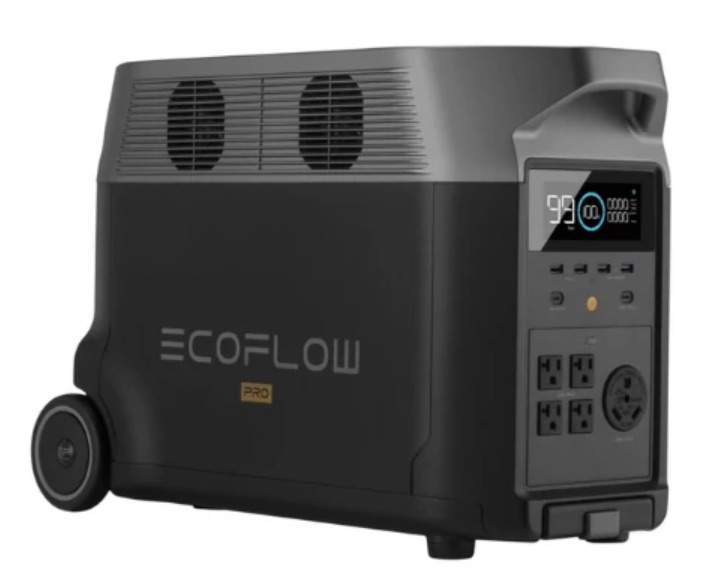
The EcoFlow Delta Pro is a powerful and versatile solar generator that provides reliable and sustainable power for a wide range of applications.
Brief Overview
The EcoFlow Delta Pro is a powerful solar generator designed to provide reliable and portable energy solutions. It’s currently EcoFlow’s largest power station and it can be expanded into many configurations.
Over the years, EcoFlow has proven that its portable power stations have both fast recharging speeds and high output power capabilities. The first Delta model from the company was the Delta 1300, which showcased EcoFlow’s X-Stream charging and X-Boost output technology to enhance its performance.
From the release of the Delta 1300 to today’s Delta Pro, the performance characteristics have significantly improved.
Delta Pro – Specs
The EcoFlow Delta Pro comes with impressive specifications that make it a top-of-the-line solar generator:
| Model | EcoFlow Delta Pro |
|---|---|
| Dimensions | 25 x 11.2 x 16.4 in (63.5 x 28.4 x 42 cm) |
| Output Ports | 5x AC outlets: 3,600W total, 7,200W surge (X-Boost max power: 4,500W) 2x Standard USB-A outputs (12W each) 2x USB-A Fast Charge (18W each) 2x USB-C outputs (100W each) 1x DC car output port (12.6V/10A) 2x DC5521 outputs (12.6V/3A each) 1x Anderson output (12.6V/30A) |
| Input Port(s) | 1x Solar (PV) input port (also functions as the car input port) 1x AC adapter input port |
| Recharging Power | Solar Input: 11-150V, 15A max (1,600W max) 120V AC Charger: 15A (1,800W max) 240V AC Charger: 12.5A (3,000W max) Car Charging: Supports 12V/24V battery, 8A |
| Battery Capacity | 3,600Wh (supports up to 2x DELTA Pro Smart Extra Batteries) |
| Battery Cycle Life | 3,500 cycles to 80% capacity |
| Weight | 99 lbs (45 kg) |
| Warranty | 24 months |
| Manual | Delta Pro user manual |
| Cost | $3299 |
| Where to Buy | 1. Amazon 2. Shop Solar Kits 3. EcoFlow |
Features of the Delta Pro
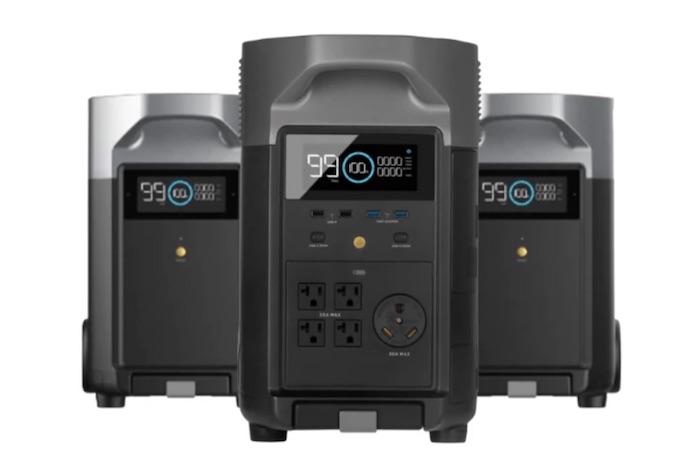
- EcoFlow App: You can control this power station using your smartphone with EcoFlow’s mobile application. You can power your system on and off, track your usage, and review estimated charging times all via your phone.
- Convenient Charging: The Delta Pro can reach a charging wattage of up to 6,500W. This is a lot of power, and it’s accomplished by combining multiple charging methods, including solar panels, AC charging, and EcoFlow’s Smart Generator (gas generator). AC charging is the most powerful, where you can charge at speeds of up to 3,400W using an EV charger.
- Battery Expandability: The Delta Pro has expansion batteries that connect to the Delta to give you added capacity for longer run times. You can connect two expansion batteries to each Delta Pro. You can also connect two Delta Pros together with this setup for over 20kWh of battery availability.
- Home Backup Power: The EcoFlow app has a “Whole-Home Backup Kit” that includes a transfer switch to install in your home. When the power goes out, you can use the transfer switch to apply the Delta Pro’s power to your appliances.
- Output Power Options: The Delta Pro features a robust 3,600W AC output, expandable up to 4,500W with X-Boost technology (EcoFlow’s proprietary technology). This allows it to power most heavy-duty appliances. For even greater power output, two units can be paired together to achieve a total of 7,200W of output power.
Pros & Cons – Delta Pro
Pros
- High-Powered: Versatile power output suitable for various applications. Plus, its X-Boost feature adds more wattage to your AC ports if needed.
- Expandable Capacity: Additional smart batteries/generators can be added to accommodate off-grid power needs.
- Fast-charging Capabilities: MultiCharge technology lets you recharge fast by either using a single charging method or by combining multiple methods for up to 6,500W of charging power.
- Long-lasting LFP Battery: With an impressive cycle life of 3,500 cycles to 80% capacity, this allows you to use the Delta for a long period of time without needing to replace the battery. Its LiFePO4 battery can last roughly 2-5 times longer than portable power stations using lithium-ion batteries.
Cons
- Solar Input Power: At 1,600W maximum, the solar panel charging is fast if you’re only using a single Delta Pro. However, adding more Smart Batteries to your system would limit its charging capabilities. If it takes 3-4 hours to recharge the Delta with this solar input, adding a single Smart Battery to your setup would double the recharging time to 6-8 hours.
- Pricing: Although a single Delta Pro costs the same as other competitors in the solar generator space, each additional component added makes the total cost much higher. For example, adding four EcoFlow 400W solar panels and one transfer switch costs $2,400 on top of the cost of the Delta Pro.
Overall Thoughts
The EcoFlow Delta Pro is a feature-rich and high-performance solar generator that caters to a wide range of power needs.
With its massive capacity, multiple AC outputs, and fast-charging capabilities, the Delta Pro is a reliable solution for home backup, outdoor adventures, and professional work settings.
Its long-lasting battery, plug-and-play setup, and travel-friendly design make it a top choice for users seeking a robust and sustainable power source.
3. Bluetti AC200P Solar Generator
With a 2,000Wh battery, 2,000W continuous AC inverter, and a total of 17 output ports, the Bluetti AC200P can deliver power to several devices and appliances simultaneously for extended periods of time. Its unique features include a touchscreen LCD display and wireless charging ports.
Bluetti has created high-tech power stations that are a step above the rest of the competition. The AC200P is a clear example of innovation in the portable power industry.
Not only were they the first company to have a touchscreen on their power stations, but they were also one of a handful of companies to put a LiFePO4 battery in their systems.
With this battery, you will find that compared to lithium-ion power stations, the LiFePO4 cell type in the AC200P will last 1.5 to seven times longer. This is not an overstatement either.
Take the Yeti 1500X for example. It has a cycle life of 500 cycles to 80% capacity. The AC200P has 3,500 cycles to 80% capacity. You would have to buy seven Yeti 1500Xs to last the same amount of time that the AC200P would.
Each 1500X costs $2,000. If you wanted to get the same long-term power from its battery, you would be paying $14,000. The AC200P costs $1,700.
Bluetti AC200P Specs
| Model | Bluetti AC200P |
|---|---|
| Dimensions | 16.5 x 11 x 15.2 in |
| Output Ports | 6x 100-120V AC outlets (2,000W continuous, 4,800W surge) 1x DC cigarette lighter output port (12V/10A) 4x Standard USB-A outputs (15W each) 1x USB-C PD output (60W) 2x Wireless charging ports (15W each) 2x Standard DC outputs (12V/3A) 1x RV DC port (12V/25A) |
| Input Port(s) | 1x Solar (PV) input port (also functions as the car input port) 1x AC adapter input port |
| Recharging Times (at Max Input) | Solar (700W): 3.5-4 hrs AC Wall (400W): 6-7 hrs Car (100-200W): 10 hrs (24V); 20 hrs (12V) Dual AC Wall (800W): 3-3.5 hrs Solar + AC Wall (1,100W): 2.5-3 hrs |
| Battery Capacity | 2,000Wh |
| Battery Cycle Life | 3,500+ cycles to 80% capacity |
| Weight | 60.6 lbs |
| Warranty | 24 Months |
| Cost | $1,699.99 |
| Where to Buy | 1. Amazon 2. Bluetti 3. Shop Solar Kits |
Features of the Bluetti AC200P
- LCD Touchscreen: Similar to the EP500, the AC200P has a touchscreen that shows you battery and port information as well as warning indicators to protect its battery.
- Wireless Charging: Two wireless charging pads are located on top of the power station for seamless device charging (15W max per port).
- Dual AC Wall Charging: With two wall chargers, you can input up to 800W of power to recharge the AC200P in 3-3.5 hours.
- Solar + Wall Charging: This is the fastest way to charge the power station. One 400W wall charger with 700W of solar panel input will recharge it in as little as 2.5 hours.
- RV DC Port (12V/25A): Most solar generators don’t have an RV port, but the AC200P has one that can output up to 300W of power to your RV.
Pros & Cons of the AC200P
Pros
- Fast recharging: Fast recharging times give the AC200P an advantage over similar generators. For example, all of Goal Zero’s Yeti X-series solar generators do not have as high of a solar input as the AC200P’s 700W.
- Long-lasting LiFePO4 battery: With 3,500+ battery cycles to 80% capacity, you will have a long-lasting system that will outlast nearly all lithium-ion power stations.
- Several output ports: Its 17 output ports can charge/power several items at the same time. This is a high number of ports for any solar generator.
- LCD touchscreen: LCD touchscreens are uncommon in any solar generator. With a touchscreen, you can navigate several settings and review more data than the average LCD screen would permit.
Cons
- Heavy: The AC200P weighs over 60 pounds, which makes it about 17 pounds heavier than the Jackery Explorer 2000. Both of these power stations have similar-sized batteries. However, the Explorer 2000 uses a lithium-ion battery, making it much lighter.
- No wheels: There are no wheels on this power station. It would be convenient to have them since the system weighs more than the average person can carry. The best way to carry it is with two people – each taking ahold of one carrying handle.
Bluetti AC200P – Closing summary
I recommend the AC200P because its battery will last for years and potentially over a decade depending on how often you use it.
With its high-tech features (touchscreen, wireless charging, etc.), it can meet different user needs while also providing detailed information so you can understand how your system is working.
The AC200P is the successor to the lithium-ion-powered AC200. For a detailed look into the differences in performance, I have an article comparing them side-by-side here: Bluetti AC200 vs AC200P – Key Differences & Takeaways.
4. Renogy Lycan 5000 Power Box Solar Generator
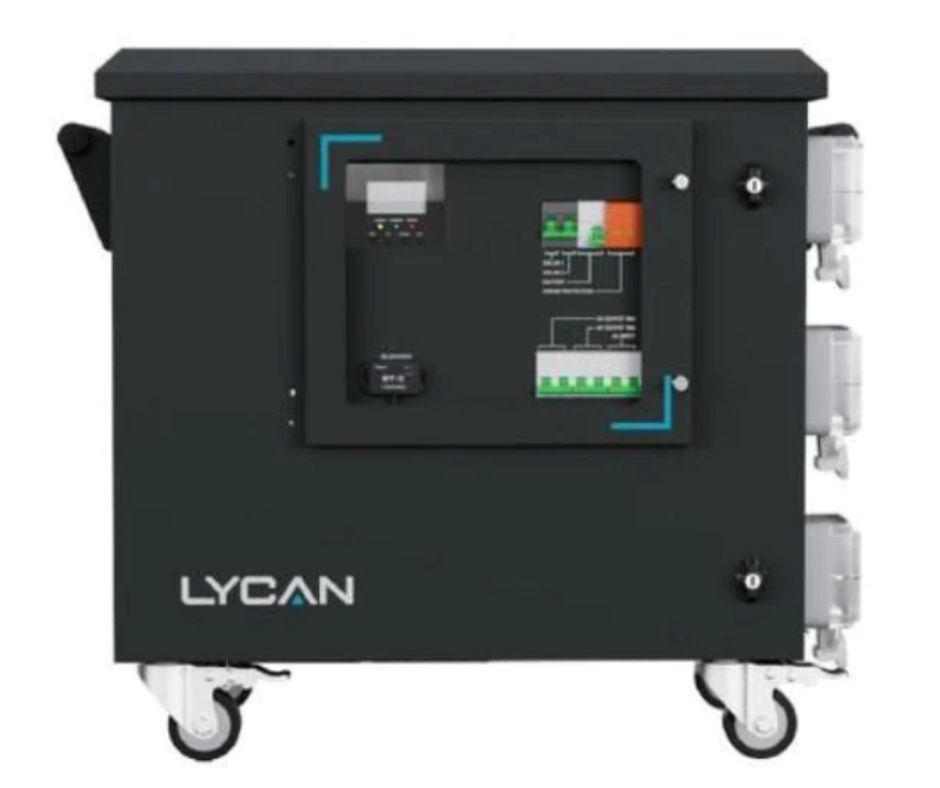
The large and powerful Renogy Lycan 5000 Power Box is a highly versatile and reliable energy storage system designed to meet the power needs of both emergency situations and off-grid living.
The Renogy Lycan 5000 Bower Box is both a powerful and reliable solar generator because it excels in four important areas:
- Output power
- Solar recharging
- Battery capacity
- Battery longevity
The Predecessor to the Lycan 5000
This is the largest portable power station in Renogy’s history. In fact, there was a predecessor to this model, also call the Lycan Power Box. It was one-fourth the size of the Lycan 5000 and had a 1,075Wh battery. Its performance was much different than the current version. It had a 1,200W continuous AC output and a 300W maximum solar intake.
Knowing this information will help to show you how massive the differences are between the old and new Lycan Power Box versions. Below are some specs of the new Lycan 5000 model.
Overview of the Lycan 5000
The generator operates on a 48V DC lithium iron phosphate battery with a capacity of 4.8kWh. Additionally, it comes with a battery expansion capability of up to 19.2kWh. This battery is also designed to deliver exceptional performance with a cycle life of 4,500 cycles to 80% capacity.
The Lycan 5000 offers a reliable and efficient power output, reaching a continuous AC output of 3,500W. As for recharging, its maximum solar input power of 4,400W allows for reliable power generation when off the grid.
Lycan 5000 Power Box – Specs
The Lycan 5000 Power Box boasts impressive specifications that contribute to its exceptional performance and reliability. Here are some key specs of the Lycan 5000:
| Model | Renogy Lycan 5000 Power Box |
|---|---|
| Dimensions | 32.9 x 20 x 28.5 in (83.5 x 50.8 x 72.4 cm) |
| Output Ports | 4x AC Outputs: 2x 20A; 2x 30A Rated Output Power: 3500W Peak AC Output Power: 7000W |
| Input Port(s) | 2x Solar (PV) input ports 1x AC input port |
| Recharging Power | Solar Input: 4,400W max AC Charger: 2,400W max Solar + AC charging: 6,800W max |
| Battery Capacity | 4,800Wh (supports Renogy 48V 50Ah Smart LiFePO4 Batteries) |
| Battery Cycle Life | 4,500 cycles to 80% capacity |
| Weight | 264.6 lbs (120 kg) |
| Warranty | 36 months |
| Manual | Renogy Lycan 5000 manual |
| Cost | $3,699 |
| Where to Buy | 1. Renogy 2. Shop Solar Kits 3. Amazon |
Features of the Lycan 5000
- Versatile: Designed for both indoor and outdoor installations, the Lycan is equipped with a rugged enclosure featuring an IP55 protection rating, ensuring its durability and resistance to various environmental conditions.
- Smartphone Monitoring: The Lycan 5000 comes equipped with the Renogy BT-2 Bluetooth Module, allowing users to pair the power box with the Renogy ONE M1 for real-time monitoring. You can stay updated on the charging status and other important information through the DC Home app.
- Fast Charging: Thanks to its versatile design, the Lycan 5000 can be charged in just one hour from 0% to 80% capacity when connected to both solar panel and AC charging inputs.
- Battery Expansion: The Lycan 5000 is designed to allow easy expansion to up to 19.2kWh by integrating additional Renogy 48V 50Ah Smart Lithium Iron Phosphate Batteries. This scalability makes it suitable for a wide range of power needs.
Pros & Cons of the Lycan 5000
Pros
- Fast Solar Charging: The Lycan 5000 has a 4,400W max solar input, considerably higher than most other solar generators.
- Output Power: Its powerful continuous AC output of 3,500W makes it suitable for running heavy-duty home appliances and outdoor devices.
- Long-lasting: Its LiFePO4 batteries carry a cycle life of 4,500 cycles to 80% capacity. To put this into perspective, the Goal Zero Yeti 6000X has a cycle life of 500 cycles.
- Built with Safety in Mind: Safety is a priority with the Lycan 5000, as it comes equipped with circuit breakers and surge protection devices to ensure safety for connected equipment and appliances.
Cons
- Output Options: With only four AC output ports to choose from, the Lycan is mainly meant for high-powered needs. It lacks the USB, Anderson, and other DC output ports that most of its competition includes in its power stations.
- Weight: At nearly 265 pounds, its heavyweight design limits its ability to be transported. Its wheels give you some mobility, but it requires precaution if you’re trying to lift/lower it.
Closing Thoughts on the Lycan 5000
The Renogy Lycan 5000 Power Box has the core elements of a high-quality and reliable solar generator: a large battery, powerful output, high solar input, smartphone monitoring, and battery expansion options.
The durable LiFePO4 batteries and built-in protection features ensure reliability and safety for connected devices, making it an excellent long-term investment for those seeking an uninterrupted power supply.
5. Bluetti EB70S Solar Generator
The Bluetti EB70S is a 716Wh portable power station weighing in at 24.1 pounds. It can charge from solar panels in 3-4 hours with its 200W input and its AC ports can output up to 800W of continuous power to your appliances and devices.
This is one of the lightest LiFePO4 solar generators on the market (second to the 16.5-pound Bluetti EB55), yet the EB70S delivers a lot of power for its size.
The EB70S delivers 2,500 battery cycles to 80% capacity, which means it will last about five times longer than similar systems that use lithium-ion batteries.
For example, the Jackery Explorer 1000 has 500 cycles to 80% capacity.
At 716Wh, the EB70S is in a unique size category as there are only two power stations that come to mind that are close to this battery size – The Patriot 1800 (768Wh) and the EcoFlow River Pro (720Wh).
Compared to these two similar-sized power stations, the EB70S is one-fourth the price of the Patriot 1800 and it has five times as many battery lifecycles as the EcoFlow River Pro.
Bluetti EB70S Specs
| Model | Bluetti EB70S |
|---|---|
| Dimensions | 12.6 x 8.5 x 8.7 in |
| Output Ports | 4x 100-120V AC outputs (800W continuous, 1,400W surge) 1x DC car port (12V,10A) 2x DC outputs: 5.5mm x 2.1mm (12V,10A) 2x USB-A outputs (5V,3A) 2x USB-C PD outputs (100W) 1x Wireless charging pad (15W) |
| Input Port(s) | Solar/car/wall Input: 12V~28V (200W max) |
| Recharging Times (at Max Input) | Solar (200W): 4-4.5 hrs AC wall outlet: 4-4.5 hrs 12V car port: 7.5 hrs |
| Battery Capacity | 716Wh |
| Battery Cycle Life | 2,500+ cycles to 80% capacity |
| Weight | 21.4 lbs |
| Warranty | 24 months |
| Cost | $599.99 |
| Where to Buy | 1. Amazon 2. Bluetti 3. Shop Solar Kits |
Features of the Bluetti EB70S
- LED Flashlight: On the front of the EB70 is a flashlight with three modes: full brightness, half brightness, and SOS flash mode.
- Two 100W USB-C PD Ports: Only EcoFlow and Bluetti have 100W USB-C ports on their power stations. These two 100W ports will be able to charge laptops and other devices as fast as possible.
- Wireless Charging Pad: As with the previous solar generators mentioned, this Bluetti has a 15W (max) charging pad for phones and tablets.
- Lightweight LiFePO4 Battery: At just over 21 pounds, the EB70 is the lightest LiFePO4 battery for its size. Its competition is the Patriot Power 1800, which weighs 40 pounds yet is around the same size.
Pros & Cons of the Bluetti EB70S
Pros
- Inexpensive: The EB70 is $600, which is the same price as the EcoFlow River Pro. The River Pro uses a lithium-ion battery with 500+ cycles to 80% capacity. The EB70 has 2,500 cycles to 80% capacity which gives it five times the lifespan of the River Pro.
- Portable: The EB70 is the most portable out of all the solar generators mentioned in this article. If you’re looking to camp or tailgate with the EB70, it is one of the best LiFePO4 options as it won’t be difficult to move it around short distances.
- 12 output ports: Several devices and appliances can be used with the EB70 because it carries most of the ports required for items such as CPAP machines, mini-fridges, 12V fridges, phones, tablets, laptops, and more.
Cons
- LCD display: The LCD screen does not inform you of voltage or amperage. It displays wattage, hertz, and battery status, but if you’re using solar panels to charge the EB70, you will have to make sure you know the correct voltage and amperage in order for it to charge its battery effectively.
- Car port not regulated: The 12V/10A car port is not regulated, meaning that if the appliance plugged into this port goes anywhere over 120W, it will not work. Some power stations have regulated car ports that go anywhere from 13-15A in order to securely power the DC appliance.
Final thoughts on the Bluetti EB70S
I recommend the EB70 because it is portable, powerful, and versatile. It has the ability to be used for several different purposes and activities but it also has a high-powered AC inverter and several output ports to choose from.
Most of all, it will last longer than most other solar generators of its size.
If you’re looking for an even more portable LiFePO4 solar generator, I recommend the Bluetti EB55. It’s eight pounds lighter and delivers similar output power to the EB70S. More information can be found in my video review & test below.

